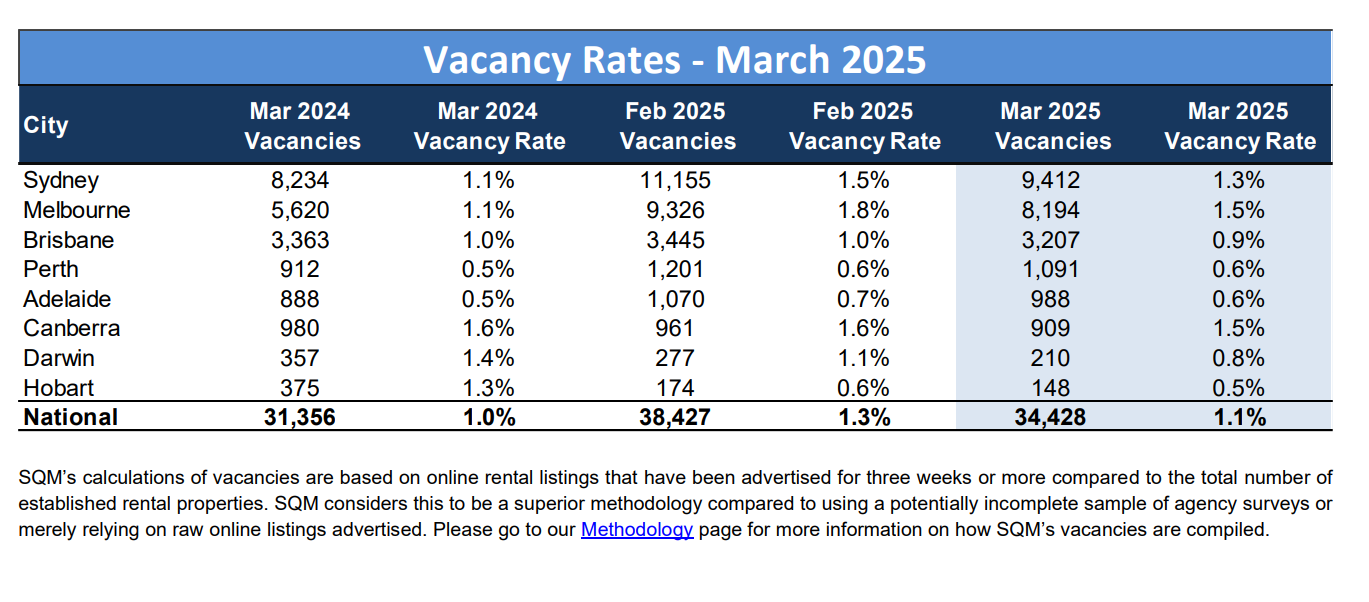

Australia’s rental market has entered another period of tightening, with the national vacancy rate falling to 1.1% in March, according to the latest figures from SQM Research.
This marks a drop from 1.5% recorded in January and reflects a continued shortage of rental listings as demand picks up in the lead-up to the holiday season.
The number of available rental properties fell to 34,428 nationally.
Sydney saw its vacancy rate decline to 1.3%, with just 9,412 rental homes on the market—down from over 11,000 in February. Melbourne also saw a drop, with its rate falling to 1.5%, leaving 8,194 properties vacant.
Other cities recorded similar declines: Brisbane’s vacancy rate dipped to 0.9% with 3,207 listings, and Darwin experienced the sharpest fall, down to just 0.8%.
However, it is Perth and Adelaide that continue to face the tightest conditions, both registering a vacancy rate of only 0.6%.

Despite the tightening in availability, rent increases across capital cities remained relatively mild.
Over the 30 days leading to April 12, national asking rents rose by 0.2%—a continuation of the slowing trend that began in early 2024.
Sydney outpaced the average, with asking rents rising by 1.0% month-on-month. Brisbane also experienced an uptick, with a 0.7% increase.
In contrast, Melbourne’s rents declined by 0.2% to an average of $647 per week, while Perth and Adelaide saw drops of 0.2% and 0.5%, respectively.
Canberra rents held steady at $686, while Hobart rose 1.2% to $537. Darwin led the price increases with a sharp 3.3% jump in average rents.
Overall, combined capital city rents climbed slightly to an average of $654 per week.
Despite the recent easing in month-to-month growth, rental prices have escalated sharply over the longer term. According to Money.com.au, national rents surged by 14.2% over the past two years, with increases of 7.3% in 2023 and 6.4% in 2024—well outpacing the broader inflation rate.
While the pace of rent growth may be slowing, housing pressure remains high across the country.
Louis Christopher (pictured), managing director of SQM Research, noted that the March declines in vacancies are in line with seasonal patterns, but the bigger issue remains unresolved.
“As stated last month, March is typically one of the peak months for rental demand, so the falls in rental vacancy rates recorded last month should not be a surprise,” Christopher said. “The rental market remains tight; however, the situation has not deteriorated markedly so far in 2025.”
He also pointed out that landlords may be moderating their expectations in some regions, which has contributed to the slower rent growth. Yet, the broader issue of undersupply persists.
“A balanced rental market is one where rental vacancy rates are in the range of 2% to 3%. Currently, no single capital city is in this range,” Christopher said.
“The combination of strong underlying growth in rental dwelling accommodation driven by ongoing surges in immigration; plus, the lack of a material increase in available rental dwellings, has kept the country in a very difficult socio-economic situation.”
